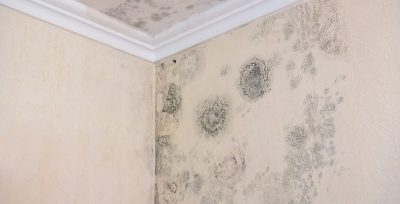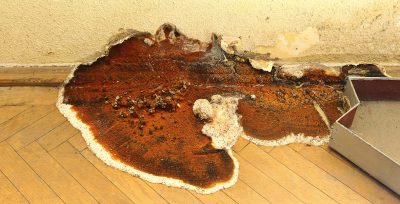Dry rot as a term can be slightly misleading since it only happens due to damp and moisture. Moisture in wood attracts some particular types of fungi. The way wood-decaying fungi work is they attack wood exposed to a certain degree of moisture and release filaments inside it in order to feed on it. This happens very quickly and once they are done with one part of the wood, they immediately spread to new parts by producing billions of new spores.
Any type of wood in the property, be it inside or outside, must be properly treated or replaced before it is newly painted. Here are a few pieces of advice on how to identify and remove dry rot problems in your home.
Dry rot’s ideal environment are closed areas with high air humidity that are hard to see and reach, such as below floorboards, inside door frames, cellars, attics, etc.
What makes dry rot so dangerous is that fungi cause it to eat away the wood and make it extremely dry, and therefore weak. Dry rot is also very hard to detect, and since it is able to spread with great speed, it can easily lead to serious structural issues.
How Does Dry Rot Affect Your Home
Dry rot is certainly not the only problem that you can face in your home, but it is hard to match in terms of damage caused. The moment dry rot fungus starts spreading within the property you will find yourself in a very bad situation.
But what makes dry rot such catastrophic? It can easily cause irreparable damage to any building, new or old. And if any piece of wood of great structural importance is affected by dry rot, it can seriously weaken the integrity of the home. This is why it is crucial to identify dry rot in the early stages and act immediately. This may sound more terrifying than it actually is, but with this big risk, why take any chances? The sooner the infestation is eliminated, the less money you will have to spend on treatment and repairs, or complete replacements.
Perhaps you are thinking of selling your house and moving to a new place. If potential buyers discover dry rot problems it will greatly affect its value and the interest in it.
Dry Rot Treatment and Services in London
What are the Causes of Dry Rot Caused?
Dry rot poses a serious threat to the structural integrity of your home. In order to deal with it properly, and even prevent it from happening in the future you need to understand what actually triggers it. Dry rot is a condition caused by a specific fungus which feeds on moist wood, making it dry and brittle.
This type of fungus breaks down the cellulose in the wood and causes it to turn brown in colour. Wood affected by dry rot is extremely dry, and as such, it is weak and prone to disintegrating.
Dry rot occurs when the wood is exposed to constant moisture of over 20%. This usually happens in isolated rooms within a property that have low air circulation and high humidity. These conditions are ideal for dry rot. It can literally happen in all types of homes, regardless if they are old or newly constructed.
How to Detect Dry Rot
Symptoms of dry rot include:
- Appearance of mycelium on the surface of the wood
- Grey-white coloured “skin” accompanied by violet patches
- Fruiting body in the form of mushrooms. It looks like a pancake, with rusty orange colour in the centre
- Red dust released around the wood by the fruiting body
Dry Rot Life Cycle
Dry rot has four particular stages:
- Spores – The fungus that causes dry rot is present in the air everywhere in the shape of spores. However, they remain dormant and activate only if the right conditions occur. If there is damp wood with over 20% moisture, they attack and use it as a source of food.
- Hyphae – Activated spores that attack moist wood grow as hyphae. They eat inside the wood and break it down, creating cobweb strands which allow the spores to travel and spread.
- Mycelium – This is a cotton-wool resembling substance which comes as a result of hyphae coming together. It continues to spread towards new, unaffected wood.
- Fruiting Body – This is the last and final stage of dry rot. The fungus gets a mushroom looking body, which is able to produce spore dust that travels through the air searching for new wood to attack.
How to Deal with Dry Rot?
Provided you catch the dry rot infestation early, you can apply wood filler after removing the affected wood parts. Let the product seep and dry for 10 minutes, then use a knife to remove any excess material and smooth the wood surface down.
Contact Dry Rot Experts
The safest way to approach dry rot problems is to let the experts deal with it. As soon as you catch any of these symptoms and suspect you have dry rot issues, call for help. The worst thing you can do is ignore the issue and hope it goes away on its own.
Get in touch with Southern Damp Proofing right away by calling 020 7971 1329 and get all the important information in regards to your dry or wet rot problem. We will make sure to provide appropriate service.
Frequently Asked Questions
What Triggers Dry Rot?
Is Dry Rot a Health Risk?
Do I Have Dry Rot Issues?
Does Dry Rot Smell?


